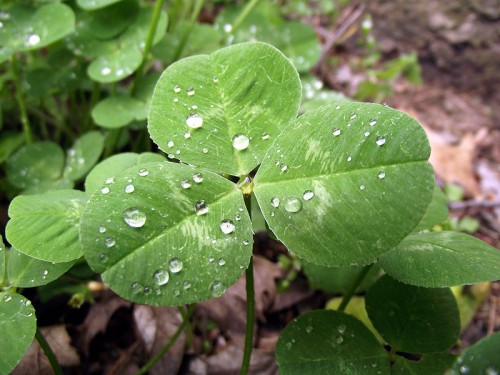Seamróga ag Seinm — Google’s Musical Shamrocks for St. Patrick’s Day Posted by róislín on Mar 17, 2015 in Irish Language

seamróg ina gnáthghnáthóg .i. seamróg nach bhfuil ag seinm uirlis cheoil agus nach bhfuil bróga uirthi agus nach bhfuil ag damhsa! Just ina luí ar an talamh atá sí! (pictiúr le supportstorm ag http://en.wikipedia.org/wiki/File:Trifolium_repens_Leaf_April_2,_2010.jpg)
(le Róislín)
Often when I see Google’s imaginative “Doodles,” I want to drop everything and write a blog about them in Irish. But somehow I never quite got around to it before.
But the seamróga in today’s Doodle seem to be a natural for some Irish vocab practice. And just to make it a little more of a challenge, we’ll present the words as a fill-in-the-missing-letters challenge.
If you’re looking at the Doodle on your computer screen, from your left to your right (freagraí thíos):
- Tá an __seamróg is __ó ag seinm na fi__le.
- Tá dhá s__eamróg eile ag damhsa. Or, hmmm, if they’re antrapamorfach, should we use “beirt“?
- Tá an ceathr__ seamróg ag seinm an __hodhráin le __ipín.
- Tá an cúigi__ seamróg ag seinm an __hain__eó.
- Tá an __seamróg is l__ ag bualadh a bos. That’s somehow assuming the shamrock is female. The word is grammatically feminine (baininscneach), so it seems a reasonable choice. But, le haghaidh an dúshláin, let’s do a masculine version: Tá an __seamróg is l__ ag bualadh a b__os.
Now let’s look at the vocab, and then why some of words undergo the changes they do.
ag seinm [SHEN-yim], playing (for musical instrument, not sports)
an fhidil [un IDJ-il], the fiddle
bainseó [BAN-shoh], banjo
beag, small, and that’s just a clue here, since we don’t have the actual word “beag” in our text. Instead we have the phrase “is l__,” meaning “smallest”
beirt, two (for counting people)
bodhrán, bodhrán (hand-held Irish drum)
bos, palm (of hand), also “of palms”; “ag bualadh a bos,” clapping her hands, lit. hitting (of) her palms
bualadh [BOO-uh-luh], hitting, striking, here “clapping”
dhá, two
ceathrú [KYAH-hroo], fourth
cipín, usually means “a match” (for lighting fires), but here, the best English translation would be ______ (freagra thíos)
cúigiú, fifth
mór, big, and that’s just a clue here, since we don’t have the actual word “mór” in our text. Instead we have the phrase “is m__,” meaning “biggest”
seamróg, a shamrock
Now I have to check and see if there’s an archive (cártlann) of the Google Doodles. Seems to me I saw something like that once but now I’ll have to track it down again. An bhfuil eolas ag duine ar bith? An féidir breathnú ar na Doodles a bhí ann cheana?
“Whack fal the di do, diddle i day,” or should that be “toora-loora-loora”? Or “didtherum doo, didtherum doo, didtherum doo-da-dee?” Róislín
Freagraí:
- Tá an tseamróg is mó ag seinm na fidle. The biggest shamrock is playing the fiddle. (NB: “t” prefixed because “seamróg” is singular and starts with “s” followed by a vowel; is mó, lit. which is biggest; na fidle, genitive case for “at playing of fiddle”)
- Tá dhá sheamróg eile ag damhsa. Two other shamrocks are dancing. (NB: lenition after “dhá,” so “seamróg” becomes “sheamróg“)
- Tá an ceathrú seamróg ag seinm an bhodhráin le cipín. The fourth shamrock is playing the bodhrán with a tipper. (NB: lenition in the phrase “at playing of,” plus the genitive ending, with “i” inserted, so “bodhrán” becomes “bhodhráin“).
- Tá an cúigiú seamróg ag seinm an bhainseó. The fifth shamrock is playing the banjo. (NB: lenition of bainseó, so it becomes “bhainseó“)
5a. The feminine version: Tá an tseamróg is lú ag bualadh a bos. b. The masculine version: Tá an tseamróg is lú ag bualadh a bhos. a. The shamrock is clapping its (her) hands b. The shamrock is clapping its (his palms). In the b. version, the word “seamróg” remains grammatically feminine, but since we’re going anthropomorphic, we can at least practice the phrase as if it were “his hands” (really, his “palms”).
beag, small; “is lú,” smallest
mór, big; “is mó,” biggest
cipín, tipper (the stick used to play the bodhrán)

Build vocabulary, practice pronunciation, and more with Transparent Language Online. Available anytime, anywhere, on any device.




Leave a comment: